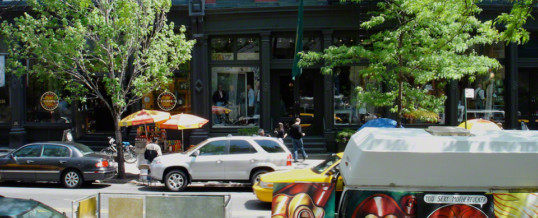
The third quarter 2011 market report compiled by appraiser Miller Samuel shows how the sales activity has increased 16.7% over the same period 2010.
Prices have been mainly stable. The dollar amount paid per square foot went up 3.2%.
International buyers continue to regard Manhattan as a special market, where foreign investments prop up demand and diminish volatility.
The rebound in the rental market is, without a doubt, an attractive point for investors that look for steady returns.
untied we win
The Real Deal magazine reports that a group of 53 Chinese-Americans got together in a syndicate to negotiate and acquire a piece of Manhattan land (where now stands a garage) in the Lower East Side. The exact location is the corner of Delancey and Pitt.
Every person involved in the syndicate is shelling $160,000 to buy the land and consequently $240,000 to develop a 53 unit condo building.
The seller, Anthony Marano, decided to go with the syndicate, instead of other possible buyers, since the offer was all cash. This cuts out a lot of uncertainty that goes with securing a lender in a still not-so-easy climate.
The syndicate formula has been adopted in the past by real estate groups that became colossal over time like Silverstein and Helmsley.
International investors are also interested in this kind of transactions, among them: Israelis, Chinese, Brazilians, Argentines and South Koreans.
The size of the deal varies between $2.5 million to $70 million generally. Investors are attracted by the stability of the New York market and sometimes are worried about their local economies.
Another incentive is the fact that, through the EB-% visa program, some investors have a chance at obtaining a green card if the project employs enough people (at minimum 10) and meets other parameters dictated by the law.
disasters
Hurricane Irene and the recent earthquake that rattled the East coast remind us of the disasters that occurred in New York City over the centuries.
During the American Revolution, about 40% of the buildings in Manhattan were compromised by the English occupation. The civilian population dropped from 25,000 to 3,000.
The Great Fire started on December 16, 1835 and burned down about 20 blocks in the vicinity of Wall Street. The Stock Exchanged was destroyed together with 600 buildings. The subsequent reconstruction was speedy. Within the end of the next year 500 new buildings were built.
The 1863 Draft Riots brought 100 victims and 50 buildings ruined. The riots prompted new laws for better New York tenements where poor people were living in the utmost uncomfortable arrangements.
The single most tragic day in the history of New York City, before 9/11 happened, was June 15, 1904. The vessel General Slocum, docked in East River near the Lower East Side, caught fire. There were 1,000 casualties.
The blackout that happened during the summer 1977 ignited a casual and tragic escalation of violence. The difficult economic situation that brought the City close to bankruptcy was the fundamental cause that pushed a great number of thugs to mischief. 1,616 stores were badly damaged and 1,000 fires dotted the City, especially the outer boroughs. The bill for this destruction was estimated at $300 million.
We all remember the 9/11 attacks. That day more than 3,000 people died in the Twin Towers attack and about 14 million square feel of commercial office space tragically turn to dust.
Canadians
In the recent past the Canadian dollar has been relatively strong.
Investment funds owned by our neighbors from the north are again betting heavily on New York City. In 2011 they bought prime rate commercial real estate here, lots of it: with $2 billion invested, so says the research firm Real Capital Analytics, they are leading foreign investments (Middle East and Asia are tied at $1.4 billion and Europe follows at $1.1 billion).
The Canadians are back at investment levels comparable to the pre-crisis time (the 2007 figure was $2.1 billion). This is a big jump from the recession levels. In 2008, 2009 and 2010 the capital employed was respectively: $12.8 million, 23.2 million and $708.1 million.
The Canadian economy is less inclined to take systemic risks than the American one; this has proven a benefit during the financial crisis. The Canadian pension funds are well capitalized, and they are now deploying capital info safe assets that can deliver steady returns on investment.
Compared to the global scenario, New York is still considered a safer haven for solid investments.
This is it for today, my Dear Friends.
I am always available to answer your questions and provide you with more information on your next real estate investment in the Big Apple.
I will be glad to get back to you.
Warm Regards,
Riccardo Ravasini
Photo by Mario Bucolo, all rights reserved: www.mariobucolo.info
ShareOCT
2011


